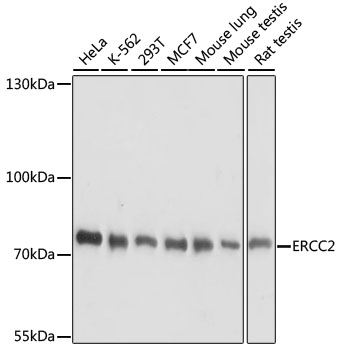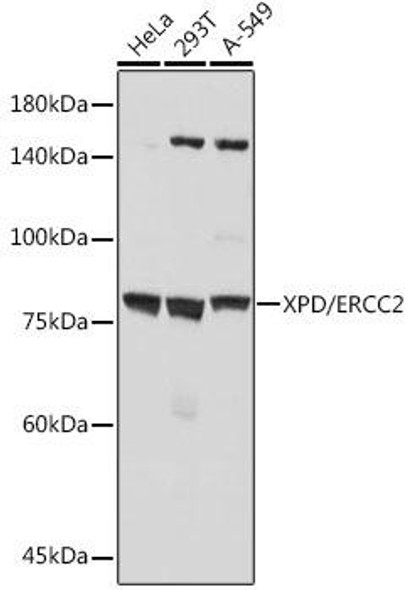Anti-ERCC2 Antibody (CAB14563)
- SKU:
- CAB14563
- Product type:
- Antibody
- Reactivity:
- Human
- Mouse
- Rat
- Host Species:
- Rabbit
- Isotype:
- IgG
- Antibody Type:
- Polyclonal Antibody
- Research Area:
- Epigenetics and Nuclear Signaling
Description
| Antibody Name: | Anti-ERCC2 Antibody |
| Antibody SKU: | CAB14563 |
| Antibody Size: | 20uL, 50uL, 100uL |
| Application: | WB IF |
| Reactivity: | Human, Mouse, Rat |
| Host Species: | Rabbit |
| Immunogen: | Recombinant fusion protein containing a sequence corresponding to amino acids 1-180 of human ERCC2 (NP_001124339.1). |
| Application: | WB IF |
| Recommended Dilution: | WB 1:500 - 1:2000 IF 1:50 - 1:200 |
| Reactivity: | Human, Mouse, Rat |
| Positive Samples: | HeLa, K-562, 293T, MCF7, mouse lung, mouse testis, rat testis |
| Immunogen: | Recombinant fusion protein containing a sequence corresponding to amino acids 1-180 of human ERCC2 (NP_001124339.1). |
| Purification Method: | Affinity purification |
| Storage Buffer: | Store at -20°C. Avoid freeze / thaw cycles. Buffer: PBS with 0.02% sodium azide, 50% glycerol, pH7.3. |
| Isotype: | IgG |
| Sequence: | MREL KRTL DAKG HGVL EMPS GTGK TVSL LALI MAYQ RAYP LEVT KLIY CSRT VPEI EKVI EELR KLLN FYEK QEGE KLPF LGLA LSSR KNLC IHPE VTPL RFGK DVDG KCHS LTAS YVRA QYQH DTSL PHCR FYEE FDAH GREV PLPA GIYN LDDL KALG RRQG WCPY FLAR YSIL HANV |
| Gene ID: | 2068 |
| Uniprot: | P18074 |
| Cellular Location: | Cytoplasm, Nucleus, cytoskeleton, spindle |
| Calculated MW: | 46kDa/86kDa |
| Observed MW: | 80kDa |
| Synonyms: | ERCC2, COFS2, EM9, TFIIH, TTD, TTD1, XPD |
| Background: | The nucleotide excision repair pathway is a mechanism to repair damage to DNA. The protein encoded by this gene is involved in transcription-coupled nucleotide excision repair and is an integral member of the basal transcription factor BTF2/TFIIH complex. The gene product has ATP-dependent DNA helicase activity and belongs to the RAD3/XPD subfamily of helicases. Defects in this gene can result in three different disorders, the cancer-prone syndrome xeroderma pigmentosum complementation group D, trichothiodystrophy, and Cockayne syndrome. Alternatively spliced transcript variants encoding different isoforms have been found for this gene. |
| UniProt Protein Function: | ERCC2: ATP-dependent 5'-3' DNA helicase, component of the core- TFIIH basal transcription factor. Involved in nucleotide excision repair (NER) of DNA by opening DNA around the damage, and in RNA transcription by RNA polymerase II by anchoring the CDK-activating kinase (CAK) complex, composed of CDK7, cyclin H and MAT1, to the core-TFIIH complex. Involved in the regulation of vitamin-D receptor activity. Might also have a role in aging process and could play a causative role in the generation of skin cancers. Belongs to the helicase family. RAD3/XPD subfamily. One of the six subunits forming the core-TFIIH basal transcription factor which associates with the CAK complex composed of CDK7, CCNH/cyclin H and MNAT1 to form the TFIIH basal transcription factor. The interaction with GTF2H2 results in the stimulation of the 5'-->3' helicase activity. Interacts with Epstein-Barr virus EBNA2. |
| UniProt Protein Details: | Protein type:EC 3.6.4.12; Helicase Chromosomal Location of Human Ortholog: 19q13.3 Cellular Component: nucleoplasm; holo TFIIH complex; cytoplasm; spindle; nucleus; cyclin-dependent protein kinase activating kinase holoenzyme complex Molecular Function:ATP-dependent DNA helicase activity; protein C-terminus binding; RNA polymerase subunit kinase activity; DNA-dependent ATPase activity; protein binding; DNA binding; 4 iron, 4 sulfur cluster binding; metal ion binding; protein N-terminus binding; 5'-3' DNA helicase activity; ATP binding; protein kinase activity Biological Process: transcription from RNA polymerase II promoter; extracellular matrix organization and biogenesis; erythrocyte maturation; viral reproduction; apoptosis; positive regulation of viral transcription; positive regulation of transcription, DNA-dependent; protein amino acid phosphorylation; regulation of gene expression, epigenetic; bone mineralization; embryonic cleavage; post-embryonic development; chromosome segregation; mRNA capping; UV protection; negative regulation of gene expression, epigenetic; transcription-coupled nucleotide-excision repair; nucleotide-excision repair, DNA damage removal; aging; positive regulation of DNA binding; transcription initiation from RNA polymerase II promoter; in utero embryonic development; multicellular organism growth; nucleotide-excision repair, DNA incision; hair cell differentiation; transcription from RNA polymerase I promoter; RNA elongation from RNA polymerase I promoter; termination of RNA polymerase I transcription; DNA repair; hair follicle maturation; DNA duplex unwinding; cell proliferation; myelin formation in the central nervous system; spinal cord development; nucleotide-excision repair; RNA elongation from RNA polymerase II promoter; response to hypoxia; positive regulation of transcription from RNA polymerase II promoter; gene expression; response to oxidative stress; transcription initiation from RNA polymerase I promoter Disease: Cerebrooculofacioskeletal Syndrome 2; Xeroderma Pigmentosum, Complementation Group D; Trichothiodystrophy, Photosensitive |
| NCBI Summary: | The nucleotide excision repair pathway is a mechanism to repair damage to DNA. The protein encoded by this gene is involved in transcription-coupled nucleotide excision repair and is an integral member of the basal transcription factor BTF2/TFIIH complex. The gene product has ATP-dependent DNA helicase activity and belongs to the RAD3/XPD subfamily of helicases. Defects in this gene can result in three different disorders, the cancer-prone syndrome xeroderma pigmentosum complementation group D, trichothiodystrophy, and Cockayne syndrome. Alternatively spliced transcript variants encoding different isoforms have been found for this gene. [provided by RefSeq, Aug 2008] |
| UniProt Code: | P18074 |
| NCBI GenInfo Identifier: | 119540 |
| NCBI Gene ID: | 2068 |
| NCBI Accession: | P18074.1 |
| UniProt Related Accession: | P18074 |
| Molecular Weight: | |
| NCBI Full Name: | General transcription and DNA repair factor IIH helicase subunit XPD |
| NCBI Synonym Full Names: | ERCC excision repair 2, TFIIH core complex helicase subunit |
| NCBI Official Symbol: | ERCC2 |
| NCBI Official Synonym Symbols: | EM9; TTD; XPD; TTD1; COFS2; TFIIH |
| NCBI Protein Information: | general transcription and DNA repair factor IIH helicase subunit XPD |
| UniProt Protein Name: | TFIIH basal transcription factor complex helicase XPD subunit |
| UniProt Synonym Protein Names: | Basic transcription factor 2 80 kDa subunit; BTF2 p80; CXPD; DNA excision repair protein ERCC-2; DNA repair protein complementing XP-D cells; TFIIH basal transcription factor complex 80 kDa subunit; TFIIH 80 kDa subunit; TFIIH p80; Xeroderma pigmentosum group D-complementing protein |
| Protein Family: | TFIIH basal transcription factor complex helicase |
| UniProt Gene Name: | ERCC2 |
| UniProt Entry Name: | ERCC2_HUMAN |




